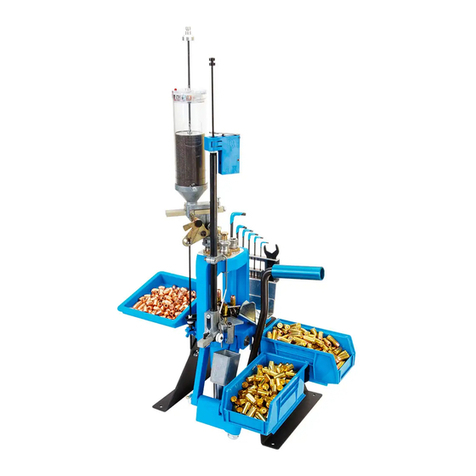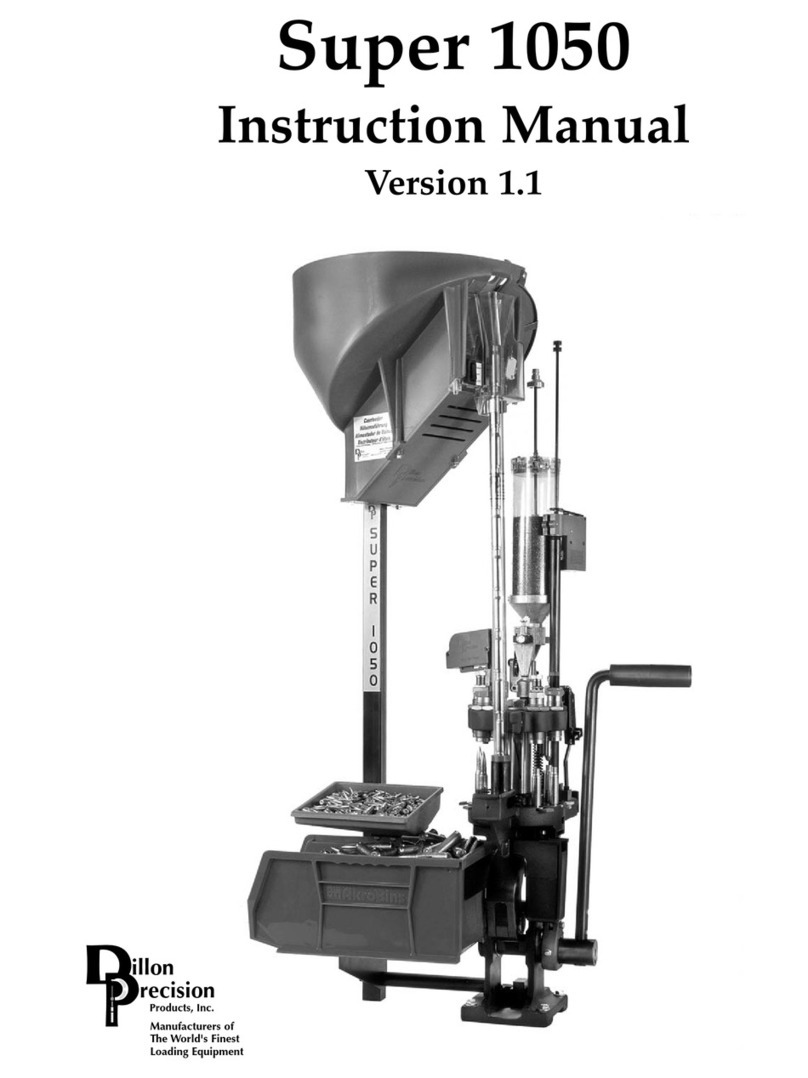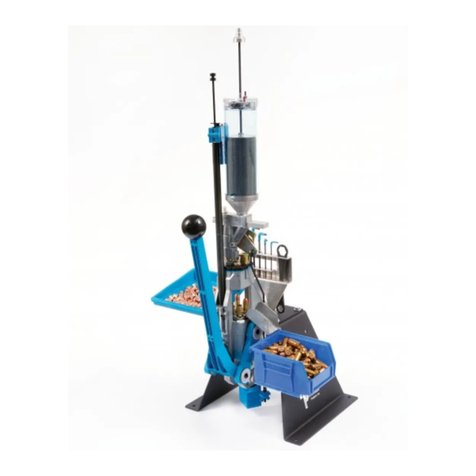Dillon Precision Products RL 550B User manual

RL 550B
Instruction Manual
Version 7.8
illon
recision
Products, Inc.
Manufacturers of
The World's Finest
Loading Equipment

RL 550B Parts List
Part # Description
13149 Manual
13409 Crank
13573 Machine Box
13583 Link Arm, Left
13644 Powder Bar Spacer
13650 Spent Primer Cup
13673 Primer Magazine, Red, Large
13691 Powder Measure Tube
13700 Link Arm Pin
13704 Handle Washer
13707 Follower Rod
13719 Cartridge Spring Retainer Screw
13720 Index Sprocket
13734 Parts Box
13747 Link Arm, Right w/Hook
13757 Primer Seating Punch, Small
13765 Roller
13775 Main Shaft
13781 Shellplate Platform
13789 1/4-2/8 Set Screw
13793 Roller
13794 Shellplate Bolt
13795 Machine Cover
13799 Stripper Wing Nut
13801 Tinnerman Nut Insert
13803 Ejected Cartridge Chute Bracket
13824 Primer Seating Cup, Large
13825 Primer Seating Cup, Small
13830 Main Shaft Pivot Pin
13834 Solid Link Arm Pin, Left
13839 Cartridge Collection Bin
13841 Nylock Nut
13845 Collar Sleeve
13848 Bellcrank Bushing
13850 Operating Handle Knob
13857 Battery Cover
13864 Switch Lever
13869 Operating Rod
13871 Bellcrank Cube
13879 Primer Magazine, Blue, Small
13881 Hollow Link Arm Pin, Right
13882 Powder Measure Lid
13885 Return Bracket
13887 Operating Rod Bracket
13889 Primer Slide Roller
13890 Spring Washer
13891 Index Ball
13893 Powder Bar Post, Large
13898 Primer Slide Stop Nut
13899 Spent Primer Catcher Chute
13904 Bellcrank Bolt, New Style
13909 Toolhead
13917 Roller Clip
13919 Slide Roller Post
13920 Primer Slide
13921 Powder Bar Spacer Plug
13923 Brass Tip Set Screw
13924 Slide Post
13925 Ejector Wire
13926 Cartridge Spring
13928 Primer Slide Return Spring
Part # Description
* 13930 Locator Buttons (3)
13939 Body Collar Clamp
13940 Body Collar - Part
13943 Powder Bar Bolt
13951 Powder Bar Post, Small
13957 Magazine Shield Cap
13958 Powder Bar Bolt Washer
13961 Slide Pickup Adjustment Screw
13964 Retain Spring Screw
13966 Shellplate Platform Bolt
13967 Primer Seating Punch, Large
13979 Primer Retain Pin Spring
13996 Primer Punch Set Screw
13997 Index Ball Spring
13998 Spent Primer Catcher Pin
13999 Primer Pickup Tip, Yellow, Small
14001 Roller Pin
14003 Flexible Orifice, Red, Large
14008 Toolhead Pin
14010 Primer Pickup Tip, Green, Large
14013 Roller Bracket Screw
14014 Primer Housing Screw
14015 Primer Track Bearing
14023 8-32x3/4 BH Screw
14024 Flexible Orifice, Blue, Small
14025 Primer Slide Return Spring Retainer
14033 Spring
14037 Clamp/Bracket Screw
14040 Retaining Clip
14051 Primer Retaining Pin
14067 Die Lock Ring
14202 Powder Measure Tube Screw
14280 Roller Bracket Shell Platform
14281 Primer Slide Assembly, Large
14282 Primer Slide Assembly, Small
17085 Dispensing Tip, Large
17086 Dispensing Tip, Small
18086 Shoulder Washer
20048 Spare Parts Kit
20059 Primer Pickup Tube, Yellow, Small
20060 Primer Pickup Tube, Green, Large
20062 Powder Bar Assembly, Small
20063 Powder Bar Assembly, Large
20064 Powder Die
* 20093 Shellplate
20094 Frame
20263 Primer Feed Body w/ Shield
20302 Primer Early Warning System
20303 Powder Measure Failsafe Kit
20339 Bellcrank
20636 Operating Handle Assembly
20782 Powder Measure System
21275 Connector Body Collar
22038 Crank Assembly
22273 Powder Body w/ Drop Tube
97000 Rod
* Indicates caliber specific parts. See the caliber conversion
chart for the correct part number for the caliber you are
loading for.
Some items listed are not shown in schematic illustration.
Part #13149 Spot Manuals RL550B Manual Folder 550B Manual.V7.8 9/01 WJC

14040
20059
13673
13707
13794
13720
20093
13966
13925
14015
13881
14025
13928
14014
13923
13747
13650
13775
13890
13409
13700
13789
13830
13890
13583
13841
13803
13839
13834
20094
13909
14067
13841
20636
Assembly
13781
13885
14008
13891
13997
13930
20302
See page 5 for
more detail.
14280
See page 5 for
more detail.
See page 4 for
more detail.
See page 5 for
more detail.
13801
97000
18086
14033
13799
3
RL 550B Schematic
17085 (large)
or
17086 (small)

13882
22273
13691
13793
14808
13940
13845
13871
97034
14041
13904
13939
14037
18086
14033
13801
13799
14067
20064
*13782
*13426
16340
14202
97000
13848
13893
20062
21353
20063
13426 * Powder Funnel, .45 cal Pistol
13644 Powder Bar Spacer
13691 Powder Measure Tube Only
13782 * Powder Funnel, .22 cal Rifle
13793 Roller
13845 Collar Sleeve
13848 Bellcrank Bushing
13871 Bellcrank Cube
13882 Powder Measure Lid
13893 Powder Bar Post, Large
13904 Bellcrank Screw
13921 Plastic Plug
13939 Body Collar Clamp
13940 Body Collar - Part
13943 Powder Bar Bolt
13951 Powder Bar Post, Small
13958 Powder Bar Bolt Washer
(not pictured)
14023 8-32x3/4 BH Screw
14037 Clamp/Bracket Screw
14041 Bowed Washer
14067 Die Lock Ring
14202 Powder Measure Tube Screws
14808 Collar Roller Bushing
16340 10-32 Nylon Lock Nut
20062 Powder Bar Assembly, Small
20063 Powder Bar Assembly, Large
20064 Powder Die
20780 Powder Bar Assembly, Extra Small
21275 Connector Body Collar - Complete
21353 Powder Bar Assembly, Extra Large
22273 Powder Measure, Part
97034 Slotted Bellcrank
20303 Powder Measure Failsafe Kit
13799 Stripper Wing Nut
13801 Tinnerman Nut Insert
13885 Return Bracket
(not pictured– see the main
schematic to identify part)
14033 Rod Spring
18086 Shoulder Washer
97000 Failsafe Rod
NOTE: * Indicates caliber specific parts –
see the caliber conversion chart for the
correct part number for the caliber you are
loading for.
WARNING
This powder measure drops a full charge of
powder each time the operating handle is
cycled. If, for any reason, you believe that
more than a single measure of powder was
dropped or you think that you may have
cycled the handle more than once on a
single case, you need to empty the case and
start over.
A double charged case can result in bodily
injury or a damaged firearm.
14202
13951 20780
13644
RL 550B Automatic Powder System
13921
14023
4

13757 Primer Seating Punch, Small
13824 Primer Seating Cup, Large
13825 Primer Seating Cup, Small
13869 Operating Rod
13887 Operating Rod Bracket
13889 Large Roller
13898 Primer Slide Stop Nut
13917 Roller Clip
13919 Roller Pin
13920 Primer Slide
13924 Primer Slide Return Spring Post
13957 Primer Shield Cap
13961 Slide Pickup Adjustment Screw
13964 Primer Feed Stop Spring Screw
13967 Primer Seating Punch, Large
13979 Primer Feed Stop Spring
13996 Primer Punch Set Screw
14003 Flexible Orifice Large (small 14024)
14010 Pickup Tube Tip Large (small 13999)
14033 Primer Seating Cup Spring
14037 Clamp/Bracket Screw
14040 Retaining Clip
14051 Primer Feed Stop Pin
17085 Dispensing Tip, Large
17086 Dispensing Tip, Small
20263 Primer Housing and Shield
22028 Primer Pickup Tube, Small
22029 Primer Pickup Tube, Large
22030 Primer Magazine, Small
22031 Primer Magazine, Large
20302 Primer Early Warning System
13707 Follower Rod
13857 Battery Cover
13864 Switch Lever
14280 Roller Bracket Assembly
13719 Cartridge Spring Retaining Screw
13765 Roller
13899 Spent Primer Catcher Chute
13926 Cartridge Spring
13998 Spent Primer Catcher Pin
14001 Roller Pin
14530 Roller Bracket Screw(s)
Complete Primer Slide Assemblies
14281 Primer Slide Assembly, Large
14282 Primer Slide Assembly, Small
;;
;;
5
13707
13864
20302
13957
14040
17085 (large)
or
17086 (small)
20060
14010
14003
20263
13967
13887
22031
13869
13857
13964
14051
13979
13961
13898
13924
13919
13917
14280
14530
13899
13765
13719
13889
13996
14033
13824
14037
14037
13998
14001
13920
RL 550B Automatic Primer System
13926
Other Dillon Precision Products Industrial Equipment manuals




















